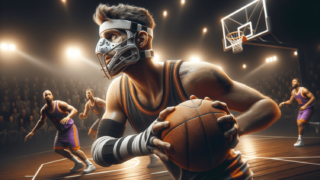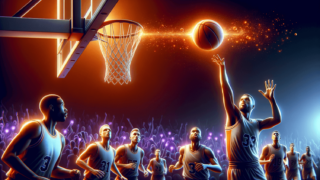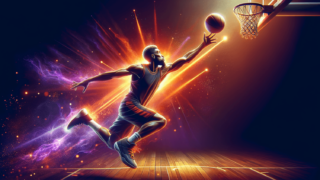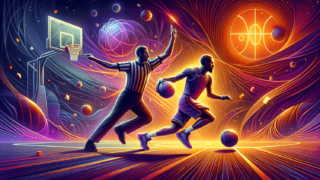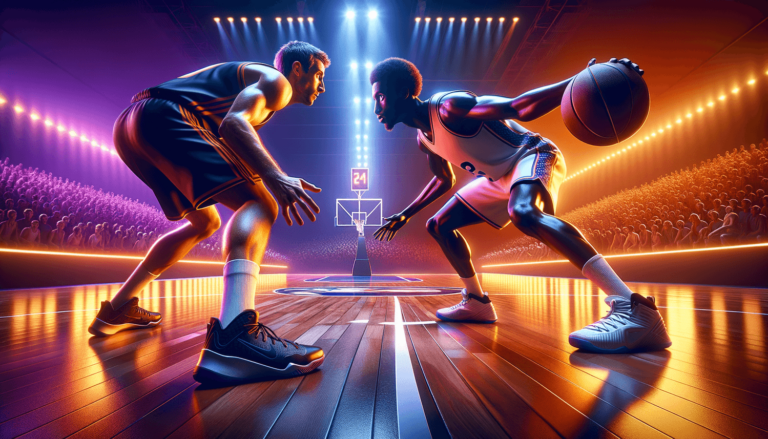
How to Improve Your Basketball Pick and Roll Defense?
Written by: Basketball Universe
Last updated:

Calling all hoop enthusiasts! Welcome to our deep dive into the fundamental art of defense. Today, we are unlocking the secrets of stifling one of the most effective plays in basketball: the illustrious pick and roll. As you maneuver through this in-depth exploration of strategies, techniques, and tips—which combines the wisdom of elite coaches and players alike—you’ll not only learn to combat this dynamic duo with grace but also have a blast outsmarting the offensive team. Batten down the hatches, tighten those laces, and let’s dive headfirst into the world of pick and roll defense like never before!
How to Improve Your Basketball Pick and Roll Defense?
To improve your basketball pick and roll defense, focus on communication, anticipate the play, and maintain proper positioning. Develop a strong understanding of the different defensive schemes, such as ICE, hard hedge, switch, and drop coverage. Work on your footwork and agility to recover quickly from screens and always have a hand up to contest shots. Additionally, study the attacking tendencies and skill sets of your opponents to make informed decisions during games.
Mastering the Art of Communication
Strong communication is the foundation of any successful pick and roll defense. Whether you’re playing with a team in a highly competitive league or just enjoying a fun pick-up game on the weekends, effective communication is essential for switching, sliding, or hedging in sync with your teammates. Let’s explore some ways to improve your on-court communication.
Establish Clear Verbal and Nonverbal Signals
Ensure that you and your teammates establish both verbal and nonverbal signals to communicate various defensive calls. Some examples are simple phrases like “screen left” or “switch” and hand signals for different coverages. Maintaining eye contact with your teammates, especially when making quick decisions, can also assist in conveying your intentions with greater clarity.
Practice Drills
Incorporate communication-oriented drills into your team practices. This not only encourages team chemistry but also enables players to familiarize themselves with each other’s voices and style of communication. When players know what to expect from their teammates and can predict their responses, they will be better equipped to defend the pick and roll effectively.
The Art of Anticipation
Anticipating a pick and roll before it happens is vital when aiming to become a more proficient defender. You must learn to read the offense, understand player positioning and movements, and recognize common cues that signal a pick and roll is in the works. Here are some valuable tips to help you improve your powers of anticipation.
Know Your Opponent
Study your opponent’s tendencies and their preferred offensive sets, including frequently-used pick and roll combinations. This knowledge will enable you to recognize when a pick and roll is coming, allowing you to position yourself and react accordingly.
Analyze Player Movements
Monitor the movements of players without the ball, since they often provide valuable hints about possible actions. For instance, certain actions like curls, or simultaneous movements by players on the weak side, may precede screens or indicate the direction of a possible pick and roll, making it easier for you to anticipate the play.
Understanding Defensive Schemes
Improving your pick and roll defense also requires knowledge of several defensive schemes. When executed correctly, these schemes help contain and neutralize the threat posed by the pick and roll, making it significantly harder for the offensive team to benefit from their basketball court strategies. Let’s examine some widely-used defensive schemes in greater detail.
ICE
ICE, also known as “down” or “blue,” is a defensive scheme commonly used against side pick and rolls. The concept involves the on-ball defender forcing the ball handler away from the screen and towards the baseline. Meanwhile, the screener’s defender positions themselves slightly below the level of the screen, ready to contain the ball handler’s attack. This tactic aims to limit the ball handler’s options and discourage them from using the screen while simultaneously providing support from the screener’s defender.
Hard Hedge
The hard hedge, sometimes called the “show,” involves the screener’s defender temporarily stepping out toward the ball handler after the screen has been set. This helps redirect the ball handler away from the basket while giving the on-ball defender time to recover. The screener’s defender must be decisive and aggressive in their movement, but also return to their original assignment as soon as possible to avoid leaving the screener open.
Switch
A switch occurs when two defenders trade assignments as a result of a screen. In a pick and roll situation, the ball handler’s defender moves to guard the screener, while the screener’s defender takes on the role of guarding the ball handler. Due to potential mismatches in size or speed, switches are typically executed only when the defenders’ skill sets complement each other, or when the game situation demands it.
Drop Coverage
Drop coverage involves the screener’s defender positioning themselves below the level of the screen while the on-ball defender remains attached to the ball handler as they navigate the pick. The purpose of this scheme is to protect the paint and deter the ball handler from driving to the basket. Adjustments may be made depending on the specific threat level of the ball handler, primarily concerning the spacing between the screener’s defender and the on-ball defender.
Building Athleticism
Maintaining the physical prowess to prevent being bogged down by screens or juked by a skilled ball handler is essential for improving your pick and roll defensive efforts. Here, we discuss various ways to increase your footspeed, agility, and overall athleticism, all critical for becoming an all-around solid defender.
Agility Ladder Drills
Agility ladder drills can assist in enhancing your footspeed, quickness, and coordination. Incorporate these routines into your regular workout schedule to navigate your way through screens more seamlessly and keep pace with attackers.
Defensive Slides
Defensive slides are one of the most essential components of basketball defense, and as such, should be mastered to perfection. The technique involves maintaining a low stance while sliding your feet, rather than crossing them, to better position yourself to react to your opponent’s movements. Allocate time in your training sessions to perfecting this movement, as it will pay dividends when defending against the pick and roll.
Strength Training
Strength training exercises, such as squats or deadlifts, can improve your ability to fight through screens by building core, upper-body, and lower-body strength. Enhanced physical resilience allows you to recover more effectively after making contact with a screener, thereby limiting your opponents’ offensive options.
Keeping it Hands-On
Improving your pick and roll defense is not all about positioning and schemes—it also requires an active and engaged approach by utilizing your hands. Let’s explore a few practical tips for better hand usage during high-pressure basketball defense scenarios.
Contesting Shots
When looking to neutralize the pick and roll threat, ensure you always have a hand up to contest shots. This can make shooting over the top of the defender more challenging, thus lowering the likelihood of a successful shot attempt.
Disrupting Passes
Active hands help to prevent your opponents from making easy passes or dribbles. By extending your arms and maintaining your balance, you can disrupt the attacker’s line of sight and, in the process, force them to make adjustments, sometimes even leading to turnovers.
Stealing the Ball
Though it should not be your primary focus, basketball occasionally offers golden opportunities for an effective steal. Keep your hands ready right above the ball handler’s dribbling zone, and if the opportunity presents itself, go for the steal with quick, decisive movements.
Defending the Scorer and the Screener
Effective pick and roll defense involves focusing on both the scorer and the screener. Let’s delve into some techniques that help you thwart the offensive tactics of your opponents.
Protecting the Ball Handler
Developing a robust defensive stance, navigating screens with speed and agility, and contesting shots can help you counter the ball handler. The aim is to utilize the proper defensive scheme and force the ball handler into less-than-ideal decision-making or uncomfortable situations.
Contending with the Screener
Stay attached to the screener to limit their offensive opportunities while remaining ready to provide help for an on-ball defender who might be late to recover. Depending on the defensive scheme, ensure you’re in the right position, maintain active hands to contest shots, and communicate with your teammates for effective defensive rotations.
Putting It All Together: Adapting and Learning
When it comes to improving your pick and roll defense in the high-energy world of basketball, one size does not fit all. Understand that adaptation and continued learning are essential components of growth in this ever-evolving sport. Whether it’s adjusting to a specific game situation or getting to know the nuances of your teammates’ playing styles, always be ready to refine and improve your pick and roll defense for superior on-court performance.
Analyzing Game Film
One often-overlooked aspect of honing your pick and roll defense skills is the analysis of game footage. By studying your own performance as well as your opponents’, you can identify areas for improvement and develop counter strategies for future games. In this section, we’ll examine how analyzing game film can boost your pick and roll defense.
Assessing Your Own Performance
Evaluating your performance on game film can reveal strengths and weaknesses in your pick and roll defense. Take note of instances where your positioning or decision-making could have been better, and learn from these situations to refine your skills. Furthermore, discussing your performance with a coach or experienced teammate can provide valuable insights and actionable advice for improvement.
Scouting Opposing Teams
Watching game film of your opponents can offer a wealth of information about their pick and roll strategy and tendencies. Take note of the primary ball handlers and screeners on the opposing team, as well as their preferred methods of executing pick and rolls. Studying these aspects can equip you with crucial information to anticipate and combat upcoming offensive plays.
Developing Team Chemistry
Team chemistry plays a crucial role in executing seamless pick and roll defense. A well-connected team can operate as a single unit, adapting to various situations and making split-second decisions as a cohesive whole. In this section, we’ll explore ways to foster better on-court connections and enhance your team’s defensive prowess.
Practice Pick and Roll Defense as a Team
Team drills targeted at strengthening pick and roll defense are essential to improving your overall performance. Dedicate regular practice time to various defensive scenarios, ensuring all team members understand their roles, responsibilities, and adjustments within the different defensive schemes.
Build Trust Among Teammates
A key component of effective pick and roll defense is trust in your teammates. Engage in team-building activities and open communication, both on and off the court, to develop a deeper bond among team members. Stronger relationships contribute to better anticipation of your teammates’ movements on the court and lead to a more cohesive pick and roll defense.
Maintaining a Competitive Mindset
A crucial element of elevating your pick and roll defense is fostering the right attitude toward competition. A competitive mindset drives you to put in the hard work necessary for improvement, pushing you to be the best defender you can be. In this section, we’ll focus on ways to develop and maintain a tenacious mentality in the realm of pick and roll defense.
Embrace Challenges
Adopt a growth mindset, embracing challenges as opportunities to improve your pick and roll defense rather than fearing failure. This positive approach allows you to learn from mistakes, make necessary adjustments, and continually enhance your skill set.
Internalize the Importance of Defense
Defense is often undervalued in comparison to offensive prowess, with many players focusing predominantly on scoring. Recognize the vital role of defense in winning games, and internalize the importance of becoming a defensive specialist as a valuable contribution to your team’s overall success.
FAQ: Pick and Roll Defense Questions
Got questions about pick and roll defense? We’ve compiled a list of frequently asked questions to help you become a formidable defender on the basketball court. Explore the answers to these common inquiries to further deepen your pick and roll defensive knowledge.
1. Why is the pick and roll such a popular offensive strategy in basketball?
The pick and roll is popular because it’s a simple yet versatile play that can create various scoring opportunities. By forcing defenders to make quick decisions, it can lead to mismatches, open shots, or driving lanes, making it a challenge for defenses to contain.
2. What are some keys to defending the pick and roll successfully?
Effective pick and roll defense involves strong communication, anticipation, proper positioning, understanding defensive schemes, agility, and active hands. Consistent practice, team chemistry, and a growth mindset are also important factors in successful defense.
3. How do I improve my footspeed for better pick and roll defense?
Perform regular agility ladder drills and defensive slides to boost your footspeed, quickness, and coordination. Incorporate these exercises into your regular training routine to enhance your ability to maneuver through screens effectively.
4. How can I fight through screens more effectively?
To fight through screens, improve your strength and body positioning, stay low in a defensive stance, and utilize quick and decisive footwork. Maintain physical contact with the ball handler and anticipate the screen direction to get around the screener more efficiently.
5. How important is communicating with my teammates on the court?
Communication is essential in pick and roll defense because it helps teammates coordinate their movements, switch or hedge effectively, and maintain optimal positioning. Clear verbal cues and nonverbal signals facilitate smoother execution of defensive schemes.
6. What are some common defensive schemes used against the pick and roll?
Popular defensive schemes include ICE, hard hedge, switch, and drop coverage. Each scheme has specific advantages and disadvantages, making it essential to understand each one to employ the most effective technique based on the game situation.
7. How do I compensate for mismatches caused by the pick and roll?
Address mismatches by maintaining strong team communication, providing help defense when necessary, and utilizing defensive rotations. Understanding the capabilities of each teammate helps facilitate effective compensation strategies.
8. How much does physical strength contribute to pick and roll defense?
Physical strength is vital to fight through screens, recover from contact, and maintain your balance while defending. Engage in regular strength training exercises, such as squats and deadlifts, to build upper-body, lower-body, and core strength.
9. How do I defend the ball handler in pick and roll situations?
Defend the ball handler by employing a strong defensive stance, navigating screens efficiently, maintaining proper positioning, and contesting shots. Choose the most effective defensive scheme for the particular matchup and force the ball handler into less-ideal choices.
10. How can analyzing game film help improve my pick and roll defense?
Game film analysis allows you to identify strengths and weaknesses in your pick and roll defense, learn from your errors, and adapt your strategy to opponents’ tendencies. Studying your performance as well as your opponents’ can provide critical insights for future games.
Featured Posts
- No pillar pages found.

